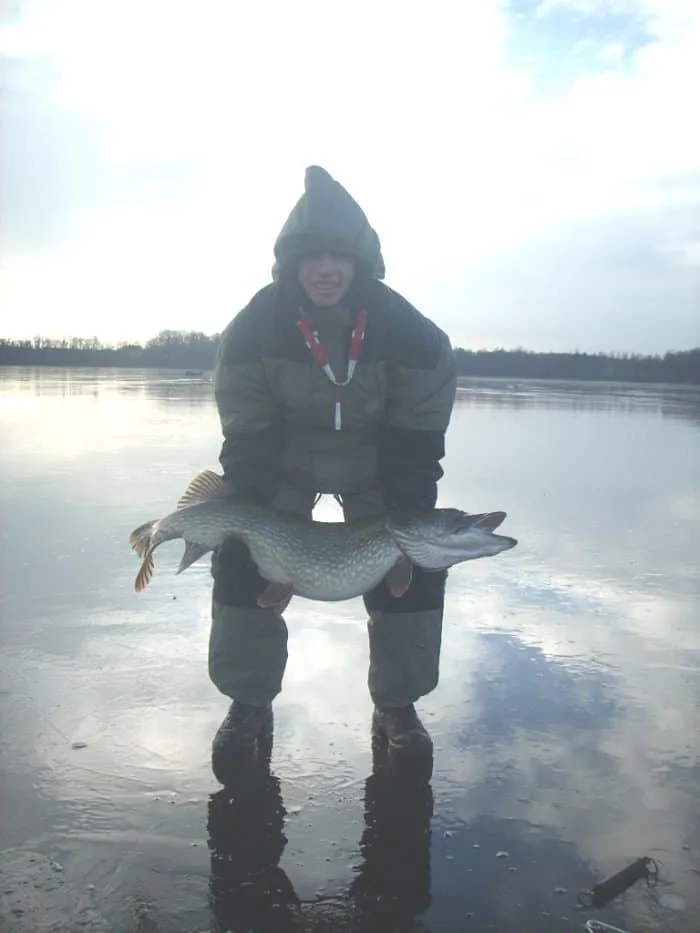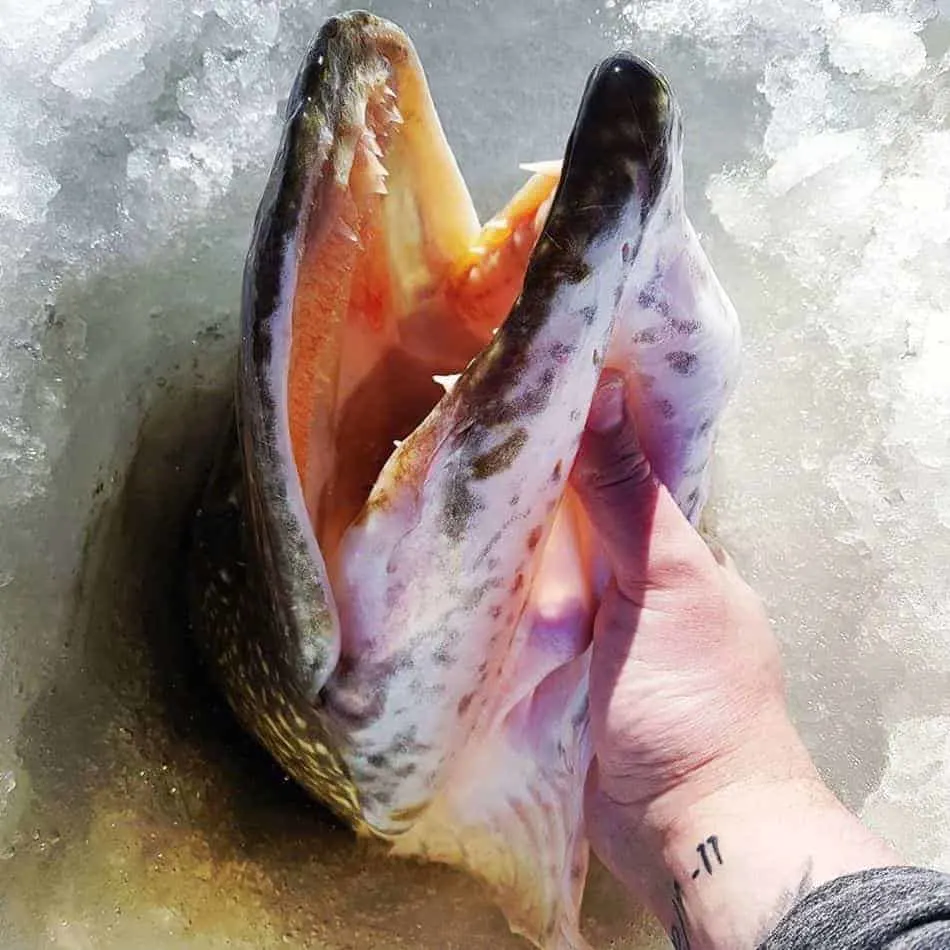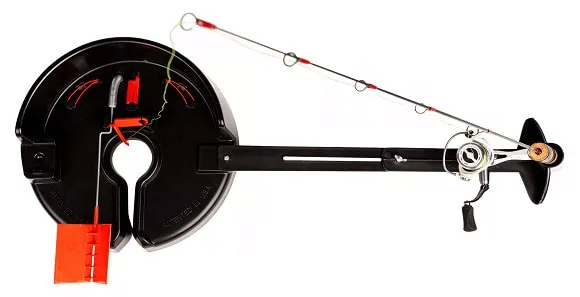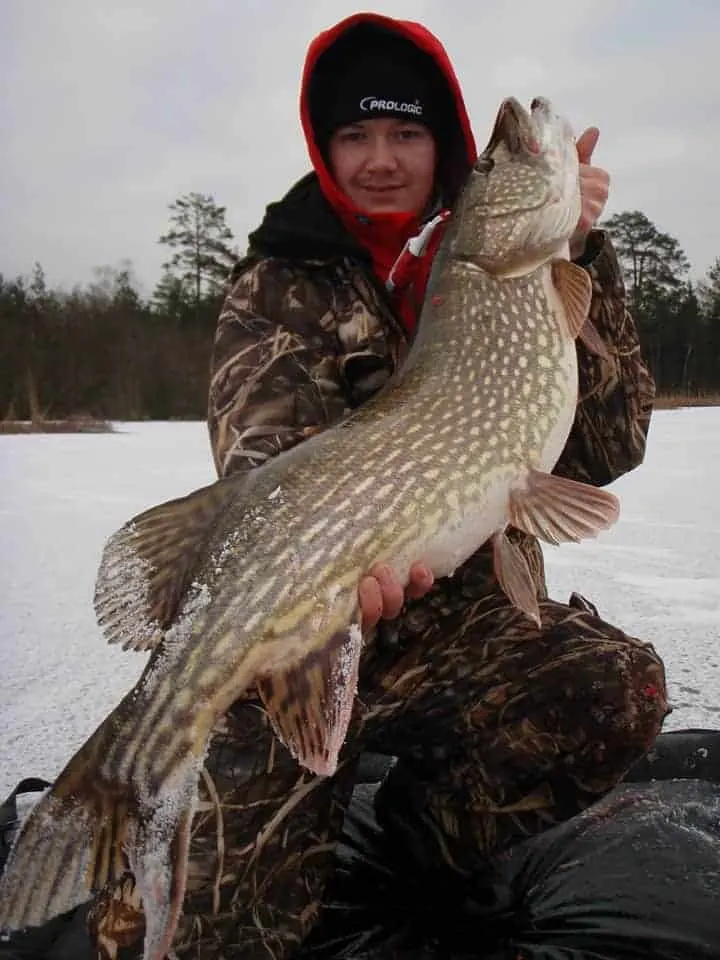Ice fishing for northern pike can be a real challenge, trust me, I have been there myself. Over the years, I have tried out different methods with varying degrees of success. But one way of catching pike has become my absolute favorite.
It is fishing with live or dead bait on 2 treble hooks and a wire leader, using a combination of a medium to heavy ice fishing rod and an iFish Pro rod holder. This will give you the best bait presentation, bite indication, and perfect control over the fight.
This method is not only extremely effective and fun, it also allows you to catch the biggest of northern pike without any difficulty. Read this article if you want to find out how exactly to fish this way.
PRO TIP: Need to gear up for your next ice fishing adventure? Then check out this essential equipment on Amazon. It’s cost-effective, durable, and gets the job done every time!
What Is theMost Effective Way to Ice Fish for Pike?

A lot of ice anglers use lures and spinning rods to target northern pike.
And while this method is a fairly active and promising one, as you can cover a large area and will eventually locate the fish, you should consider how many holes you might actually have to drill with your auger before you get your first bite.
The conditions during winter can be extremely harsh and the more holes you are drilling, the lower your energy level is getting.
I don’t know how many thousands of calories I have burned myself drilling countless holes, chasing a bite, and many times, not getting any at all after a whole day on the ice.
Then, I decided to switch my gear and implemented a totally new way of ice fishing, using live and dead baitfish. This technique not only saved me a lot of energy on each fishing trip but it also drastically increased the number of northern pike I was catching.
At first, I was using the traditional tip-up in order to be able to fish with live bait through the ice, but as you’ll be able to read further down, I quickly abandoned this setup for a far more effective one.
How Active Are Pike in Winter?
The secret lies in understanding the pike’s activity and migratory patterns during winter.
This fish actually moves around quite a lot, even in cold water, which stands in contrast to the common belief that most fish practically freeze up or become rather static in very cold water.
In fact, I have caught pike in one area of a lake, and only a few days later, I caught the exact same fish in a completely different part of that lake, several miles away from the first one!
This fact means two very important things to winter fishermen:
- No matter how many holes you drill during the day, you might still miss the pike each and every time, because they too keep moving around.
- If you want to attract pike that are located in the area you are fishing, you will have to use attractive baits that will bring the fish to your rod, not the other way around. Baitfish and especially live ones (if they are legal where you are fishing) are the perfect bait to attract northern pike in winter. But even dead baits are exquisite choices for winter pike; it’s all about the visual effect and the scent of the bait.
If you manage to make that mental switch, you are already on your way to pike success. Fish are the most natural bait you can present to pike, and especially in winter, this can make all the difference!
RELATED ARTICLE: By the way, check out this article if you are unsure about your state’s regulations concerning fishing with live bait
Do not shy away from this slightly more passive way of fishing, as you will attract more pike to your spot by using live or dead baitfish.
Not only do they smell delicious, but they are also easy prey for slow winter pike. Do not forget that they try to preserve as much energy as possible as well.
Another great advantage of this ice fishing method is that you can spread out several rods all over the area you are fishing in.
Personally, I like to fish with 2-4 ice rods, as this further improves your chances of catching, without the risk of sacrificing control.
More than 4 lines in the water can be difficult to manage if you are starting to get more than one bite at once.
Also, you would have to move around too many rods and drill too many new holes (once again: don’t forget to maintain a good energy level).
Pro Tip: Make sure to check your state’s regulations on ice fishing and check how many rods you are allowed to use on the ice!
Now that we have covered the great benefits of this ice fishing technique, let’s move on to the actual setup.
Gear Tips for Ice Fishing for Northern Pike

Rod
A common ice spinning rod will not do the job here! Imagine fighting a 20 lbs pike through a very small hole in the ice with a light spinning rod, it just won’t work very well.
Instead, try using medium to heavy ice rods with a solid backbone, as they both have a really nice action and manage to control even the strongest of pike.
But do not go for rods that are all too stiff, as you only have a limited amount of space to work with. The rod will have to manage to take some of the pike’s head shakes and runoffs, so it’ll have to have some bend to it!
Pro Tip: When fighting a big pike, stick the tip of your rod through the ice hole (if the ice isn’t too thick). This will allow you to fight the fish more freely under the ice!
Reel
A good medium-sized baitrunner is the reel of choice here. Baitrunner reels are perfect for live bait fishing, as you can simply engage its secondary drag system and let the fish run freely after it has taken the bait.
This is especially crucial for fishing in very cold water, as the fish are more sensitive and do not like to feel any weight or resistance.
As you don’t have to fish with an open bail, the risk of your baitfish running off is effectively reduced as well, should you use a bigger size or a particularly lively bait.
Fishing Line
You can safely use both monofilament, braided, or ice fishing lines, as long as you know how to ice fish the right way. The ice hole’s edges can be rather sharp and abrasion can be a serious issue.
It is for that reason that I personally prefer braided line, as it has the best abrasion resistance.
RELATED READING: Read this article if you need tips on the best ice fishing line for pike!
If you’re using another type of line, don’t worry, there is a simple trick that easily avoids any problems with abrasion.
Stick the rod tip into the fishing hole and fight off those crazy escapes with the rod tip beneath the ice. This way, the fish can move in any possible direction without your fishing line grinding along the sharp ice edges!
I prefer ice fishing with the Power Pro Spectra, which is a super high-quality braid. A 30lb test Power Pro is the perfect fit for those big old ice pike!
Leader and Hooks
There is a huge variety of pike leaders and hooks out there. Simple and qualitative material is usually the best choice, and they do not have to cost all that much!
Thicker fluorocarbon leaders of around 50-60lb are my go-to material for ice fishing pike, as they are practically invisible in the dark water under the ice and have a solid abrasion resistance when it comes to those sharp northern teeth. Find my favorite FC leader material on Amazon here.
Treble hooks should be of a size 4 or 6, as well as very robust and sharp. They both have to penetrate the baitfish and anchor themselves well into the hard pike’s mouth.
RELATED ARTICLE: Head over to this article and read up on the best leaders for ice fishing northern pike
iFish Pro Rod Holder
The iFish Pro is a next-gen tip-up that allows you to fish with a rod&reel combo, instead of using the traditional tip-up’s hand-over-hand way of landing fish.
While you use your rod to fight and land fish, rather than just a line on a conventional tip-up, you still have the tip-up flag that gives you that unforgettable bite indication.
This clever combination will make your ice fishing for pike far more fun and effective!
As a bonus, the iFish Pro comes with a 12” foam-covered base that is put above your ice hole and effectively prevents freeze-ups, making this type of gear a super comfortable and practical choice for ice fishing. You can find out more about the iFish Pro at Bass Pro Shops
Bonus Gear Tips
Fishing Chair
Spending an entire day on the ice can very very tiring, fish or no fish. Make sure to bring a lightweight and comfortable fishing chair with you, in order to relax and/or sunbathe between bites.
Thermos Bottle
Ice fishing can be rough! Especially the early mornings tend to be really cold and when all the holes are drilled and your lines are in the water, there is really nothing better than a hot cup of coffee!
Stanley thermos bottles are the very best. Take a closer look at this high-quality thermos on Amazon here.
Thermal Gloves
Handling your gear with cold and wet fingers is anything but easy! Make sure to wear a pair of nice and warm gloves when you’re on the ice.
Flip-top gloves are especially practical for ice fishing, as you can even wear them during the fight, or when handling your line.
Thermal Boots
Really warm boots that will fit your feet well are probably the most essential thing to wear on the ice.
I cannot stress enough how much discomfort and freezing cold feet will cause you!
Long-Nose Pliers
Pike have extremely sharp teeth and it can be really difficult to get our hooks out of that mouth.
Long-nose pliers are an essential tool for handling pike and will save you from those nasty bites!
Ice Picks
And last but not least, never go on the ice without wearing your ice picks. Safety first!
RELATED ARTICLE: What Time of Day is Best for Pike Fishing (A Seasonal Guide)
How to Ice Fish for Pike with Rod and iFish Pro?

Now that you know what gear to use, let’s take a look at how you should use it, in order to catch northern pike on the ice.
Pro Tip: Always drill big enough holes!
First, you must drill your holes, which should be at least 8-10 inches. You do not want to end up hooking a fat giant, only to realize that you will not get it through the ice!
I learned that the hard way myself when I caught my first 20-pounder as a teenager.
Now it’s time to get fishing! Lower your line with your baitfish through the ice hole to your preferred fishing depth.
As the fishing line will be directly above the baitfish, you will want to place the first treble hook in the fish’s back and the second one either at the root of the pectoral fin or in the mouth.
This will give you the absolute best bait presentation and the fish can move around rather freely.
Also, make sure you hook the fish not too deep and not too shallow! If the hooks are embedded too deeply into the fish, it will fatigue easily and possibly die.
If it however is hooked too shallowly, it might unhook itself and swim off. Both cases can result in a “dead” fishing hole until you check the rod.
Now, all that’s left to do is to put the iFish Pro in place above the hole, set the flag with your fishing line, put the ice rod into the rod holder, and wait!
You now have an elevated rod right next to your ice hole with a highly visible bite indicator. The set flag will move up and down a little, due to the bait fish’s movements, which is totally fine.
When a fish bites and sets off the flag, it’s time to get running; you have a bite!
Pro Tip: Use fishing bells for better indication!
Sometimes, the visual indication by the flag is not enough; the bright snow or sunlight can make it hard to see, it is too far away to spot visually, or you simply doze off while waiting.
Placing a pair of fishing bells onto the flag’s shaft will easily prevent that! Now, you have both a visual and an audible bite alarm!
What’s the Best Live Bait for Ice Fishing for Northern Pike?

If you are living in North America, the best live baitfish for northern pike would be shiners or suckers. They come in all sizes and shapes and they are usually easy to come by as well.
They too fit ice fishing for pike perfectly, as they are quite resilient and much preferred by northern pike.
If you are in Europe, the number one live baitfish to use for winter pike is definitely the roach.
Roach have enough power and energy to be able to swim around lively for hours, without swimming off too far and taking line off your reel. They are also one of the pike’s most common prey.
Pro Tip: Check online for private bait fish sellers
No matter where you live and what kind of baitfish is available in your region, you can either try to catch them yourself in a river, lake, or creek, or you simply buy them in a local fishing store or from a private seller.
If you have access to open water, the easiest way of catching larger amounts of live bait is by using a cast net. Check out my favorite net on Amazon here.
Check online platforms or forums, as there are usually people who store live bait at home and sell them for a decent price.
A good live bait size for ice fishing is anything between 4 and 8 inches. Too small fish will die off easily and won’t manage to have 2 trebles attached to them for long.
Too big baitfish will cause you a lot of trouble, as they are usually more active and can set off your flag, giving you a false bite indication.
When it comes to dead bait, the best fish to use for winter pike are mackerel. These fish have a very strong scent to them and are super rich in protein.
Take a mackerel and cut it in half, then use both ends as bait on your ice rod. I can tell you that it won’t take long before a hungry winter pike finds that delicious mackerel piece!
RELATED READING: Check out this article and find out if you can actually catch pike with hot dogs as bait
How Often Should You Switch Locations When Ice Fishing?
As you are using several rods, you have the advantage of being able to cover a large area, even though you are fishing statically.
I have found that a good rule of thumb is to move one rod every 1-2 hours if there is no action going on. This way, you are not completely abandoning your chosen area on the ice, but rather, you are expanding it!
Often, you will experience getting bites on one or two of your rods. You have simply picked the right spots for these right from the start, while your other rods are placed in areas with no fish around (at the moment).
If and when that happens, try to move the “dead” rods closer to the “action” rods, as there can be more pike around those hot spots.
On the other hand, try to avoid covering too many areas in one day! You might be fishing in a bay area close to the shore and want to try out an area in deeper water somewhere in the middle of the lake.
Or you might be thinking of fishing the opposite shoreline instead. Don’t do it! This will only fatigue you and you’ll lose too much time in between to be fishing effectively.
Instead, keep to your chosen spot and focus on discovering it fully. Try out that remote area next time you are heading out instead!
RELATED ARTICLE: Read this article to get in-depth information about the most favorable weather conditions for northern pike
How Deep Should You Ice Fish for Northern Pike?
Of course, this depends entirely on the actual depth of your chosen fishing spot. But generally, the shallower the water, the higher up the pikes are biting, and consequently, the deeper the water, the closer to the bottom the pike will be found.
When fishing in shallow bays or shore areas, try placing your baitfish fairly just beneath the ice sheet. Due to the reduced space in such areas, this will improve bait visibility and movement.
If you’re fishing in deeper water, always place your baits close to the bottom first. But do not remain there, if the bites don’t come.
Here, it can be all about experimenting with the entire range of depth. Depending on the conditions, pike can be found at any depth.
On some days, they can be close to the surface, while on others, they bite in mid-water. And sometimes, they will be found only a few inches off the bottom.
Here, another advantage of using several rods makes itself apparent, as they allow you to test a wide range of different depths.
Related Articles
All images courtesy of Mattias Epperlein and Simon Kjaeldgaard-Greising

